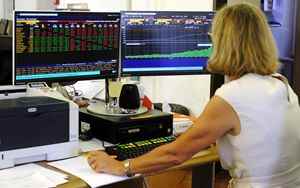(Finance) – This week’s ECB meeting was described by many as a non-event, as no new monetary policy measures or new macroeconomic projections were expected. However, looking at euro area bond yields at the end of the week, it certainly cannot be said that the moves in Frankfurt did not weigh on the markets. In statements by ECB President Christine Lagarde, who admitted the growing inflationary risks, it was read a more pronounced “hawk” tone than the market expected. This, especially today, has triggered a sharp correction of the monetary policy outlook, with implicit rates discounting an initial rate hike of 10 basis points as early as June (and 50 basis points by the end of the year). To this were added the US labor market data released this afternoon; being much better than expected, they could encourage the Federal Reserve to raise interest rates by half a percentage point at its March meeting, more than the 25 basis points priced so far.
“We still believe that a first rate hike before the end of 2022 is not (yet) on the table, as the monetary policy statement continues to state that the Governing Council expects key ECB interest rates to remain at their current or lower levels, “commented Reto Cueni, Chief Economist of Vontobel.” In addition, President Lagarde he stressed that “it is obvious that an expansive monetary policy stance to support the economy is still needed”. However, the risks of a rate hike in the current year have clearly increased, which has pushed government bond yields in Europe already higher“, added the economist.
As usual, the euro zone’s “peripheral” government bonds suffered the most. The Italian ten-year BTP ended the day up about 10 basis points with a yield of 1.74%. The differential between yield of the Italian ten-year BTP and the German ten-year Bund ended the session at 151 basis points from 145 at the previous closing. During the session, the spread fluctuated between a minimum of 141 and a maximum of 155. The ten-year Spanish it marked a 10 basis point hike to 1.03% that Greek by 18 basis points to 2.23% and that Portuguese by 9 basis points to 0.96%.
“Indeed, market participants have concluded that a change towards a hawkish stance will come in the wake of forecast revisions at the March meeting, with inflation risks clearly skewed upwards – said Mark Dowding, CIO of BlueBay – To date, the Eurotower has given forward guidance that rates will not rise until asset purchases cease. . However, with markets now expecting a 10bp hike in June, there is a sense that this will also trigger an early end of asset purchases, putting pressure on spreads in the euro zone. “
Yesterday the Bank of England raised rates to 0.5%, as expected, while a split in the vote (5-4) showed the Committee was almost ready to raise the base rate by 50 basis points; the first steps taken to implement Quantitative Tightening (QE) through the sale of corporate bonds also came as a surprise to the markets. The moves of central banks on QE will be discussed more in the coming months, as the main monetary policy institutions around the world are about to undertake “the largest quantitative tightening in history“, according to analysts at Morgan Stanley, who estimated that there will be about 2,200 billion dollars of stimulus that will be withdrawn in the next 12 months.
“The balance sheets of the central banks of the G4 (ie the Federal Reserve, the European Central Bank, the Bank of Japan and the Bank of England) will reach the peak in May“analysts of the US investment bank said, adding that the planned cuts of $ 2.2 trillion, if implemented, would be 4.5 times those of 2018, when the reduction amounted to $ 500 billion.” the balance sheet of the European Central Bank actually shrinks faster than that of the Fed from May 2022 to May 2023, given the lower liquidity provided by the Tltro “, reads the research.
